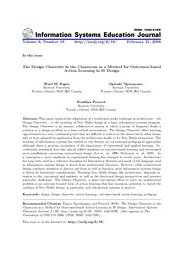Volume 6
Volume 6, Number 19 |
February 21, 2008 |
Abstract: This paper explores the adaptation of a traditional studio technique in architecture – the Design Charrette – to the teaching of New Media design in a large information systems program. The Design Charrette is an intense, collaborative session in which a group of designers drafts a solution to a design problem in a time critical environment. The Design Charrette offers learning opportunities in a very condensed period that are difficult to achieve in the classroom by other means and we have adapted its application from the architecture studio to for New Media instruction. The teaching of information systems has tended to rely heavily on conventional pedagogical approaches although there is growing recognition of the importance of experiential and applied learning. Accreditation standards have also placed added emphasis on outcome-based learning and encouraged more mindfulness concerning instructional design (Lee et. al., 1995; McGourty et. al., 1999). As a consequence, more emphasis on experiential learning has emerged in recent years. Architecture has long been used as a reference discipline for Information Systems and much of the language used in information systems design is drawn from architectural discourse. However, while architectural design combines attention to history and form as well as function, most information systems design is driven by functional considerations. Teaching New Media design, like architecture, demands attention to the conceptual and aesthetic as well as the functional design perspectives and presents particular challenges. The Design Charrette, a short but intense effort to solve an architectural problem is an outcome focused form of action learning that has enormous potential to enrich the teaching of New Media design, in particular, and information systems in general.
Keywords: design, design charrette, action learning, outcomes-based action learning, pedagogy
Download this issue: ISEDJ.6(19).Eagen.pdf (Adobe PDF, 11 pages, 515 K bytes)
Preview the contents: Eagen.txt (ASCII txt, 31 K bytes)
Recommended Citation: Eagen, Ngwenyama, and Prescod (2008). The Design Charrette in the Classroom as a Method for Outcomes-based Action Learning in IS Design. Information Systems Education Journal, 6 (19). http://isedj.org/6/19/. ISSN: 1545-679X. (A preliminary version appears in The Proceedings of ISECON 2006: §3733. ISSN: 1542-7382.)
